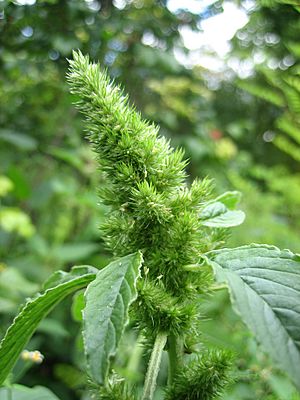Amaranthus retroflexus facts for kids
Quick facts for kids Amaranthus retroflexus |
|
|---|---|
 |
|
| Conservation status | |
| Scientific classification | |
| Genus: |
Amaranthus
|
| Species: |
retroflexus
|
| Synonyms | |
|
|
Amaranthus retroflexus is a type of flowering plant in the Amaranthaceae family. It has many common names, like red-root amaranth, redroot pigweed, common amaranth, and common tumbleweed.
Contents
About Redroot Pigweed
Amaranthus retroflexus is an annual plant, meaning it lives for only one growing season. It can grow quite tall, up to about 3 meters (10 feet) high. This plant is known for forming a tumbleweed when it dries up. A tumbleweed is a plant that breaks off at the stem and rolls away in the wind, spreading its seeds.
Where it Grows
This plant originally comes from the tropical parts of the Americas. However, it has spread all over the world. You can find it on most continents in many different places, as it's an introduced species. This means it was brought to new areas, often by humans, and now grows there.
Plant Features
The leaves of A. retroflexus can be nearly 15 centimeters (6 inches) long on larger plants. The leaves higher up on the stem are shaped like a spear, while those lower down are more diamond or oval-shaped.
This plant is monoecious, which means each individual plant has both male and female flowers. The flowers grow in a large, thick cluster, mixed with spiny green leaf-like parts called bracts. After flowering, the plant produces tiny capsules, less than 2 millimeters long. These capsules have a "lid" that opens to show a small black seed inside.
One of its common names is "pigweed" because it often grows in areas where pigs are kept for food.
How People Use It
This plant is eaten as a vegetable in many parts of the world.
As Food

While no Amaranthus plant is known to be poisonous, it's good to boil the leaves and throw out the water. This is especially true if they grew in soil rich in nitrates, as this helps remove certain natural compounds like oxalic acid. Young shoots and leaves can also be eaten raw. The leaves are very healthy, full of calcium, iron, protein, and phosphorus.
Native American groups used A. retroflexus for many food and medicine purposes. In Mexican markets, it's one of the plants eaten as a vegetable, known as Quelite quintonil.
In the Indian state of Kerala, people use it to make a popular dish called thoran. This dish is made by mixing finely cut leaves with grated coconut, chili peppers, garlic, turmeric, and other ingredients.
The seeds of the plant are also edible. You can eat them raw or toasted. They can also be ground into flour to make bread, hot cereal, or to thicken other foods.
As Animal Feed
Like many other Amaranthus species, this plant can be harmful to animals if they eat too much of it over several days. It can cause kidney problems in cattle and pigs, possibly due to its high oxalate content. Eating too much can also cause problems like bloating or other issues due to high nitrate levels. However, when given in small amounts, it is considered a very nutritious food for animals.
As a Weed
A. retroflexus is also known as a weed. A weed is a plant that grows where it's not wanted, often competing with crops. In some areas, like Northeast China, this plant has become resistant to certain weed killers (herbicides) like fomesafen. This means those weed killers no longer work well against it.
See also
 In Spanish: Amaranthus retroflexus para niños
In Spanish: Amaranthus retroflexus para niños


